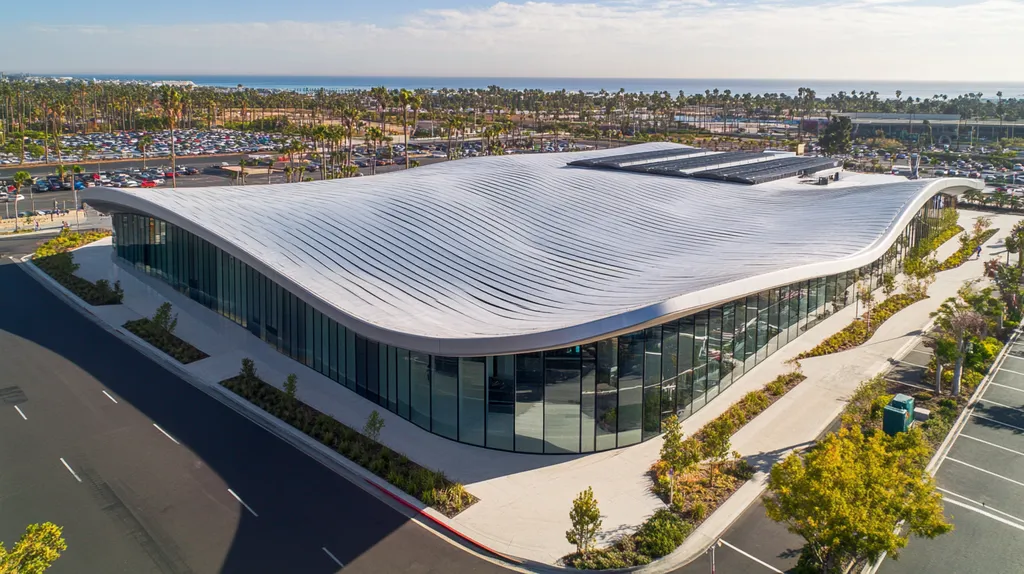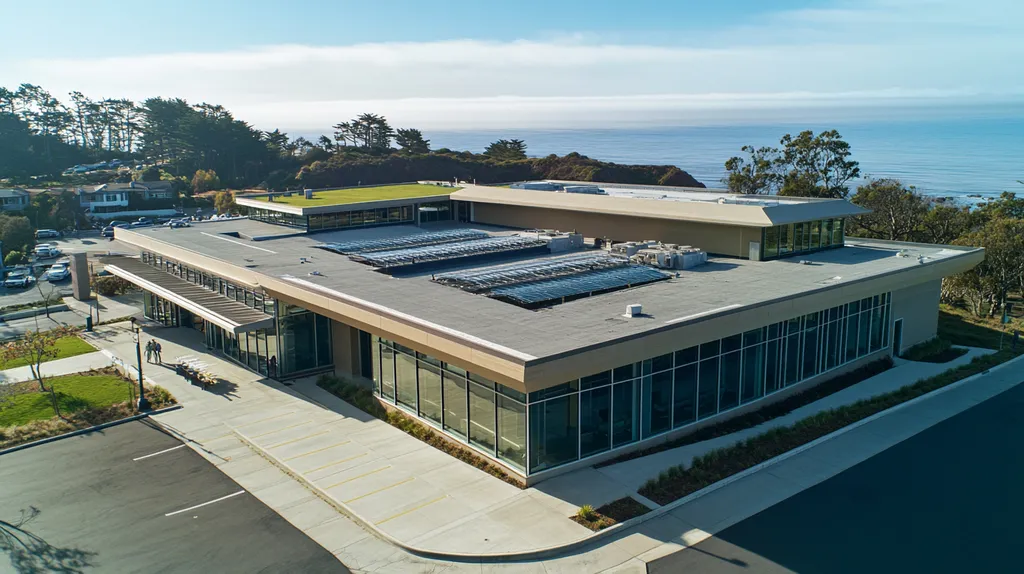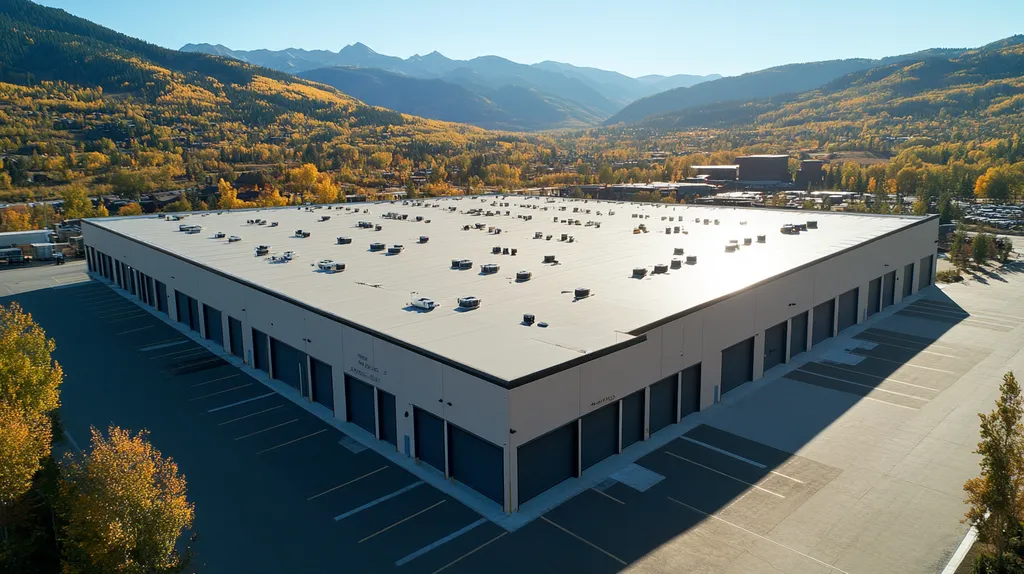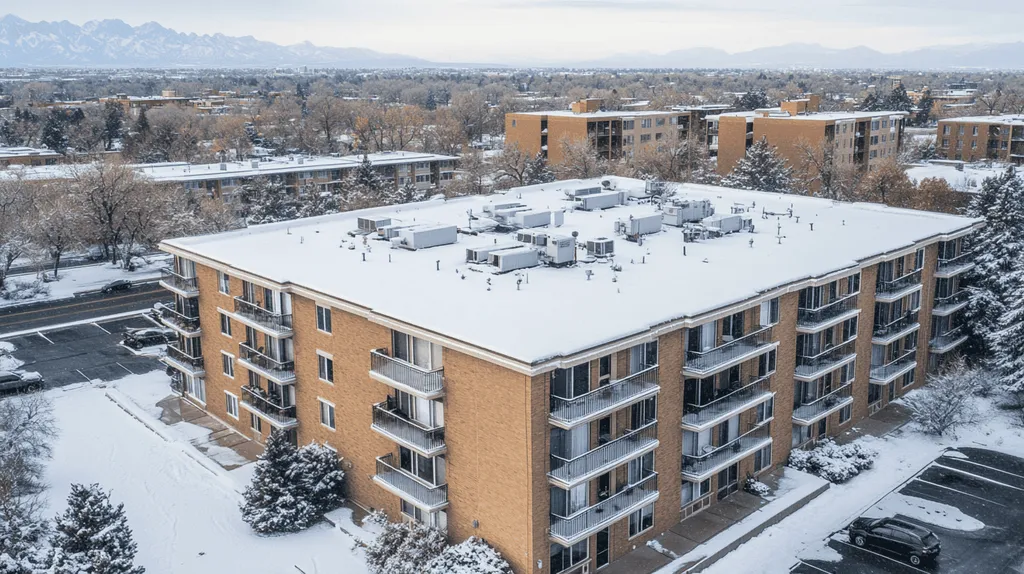Commercial roof coatings represent a critical yet often neglected investment, with improper maintenance leading to up to 40% shorter lifespans and hundreds of thousands in premature replacement costs.
Regular cleaning stands as the cornerstone of effective roof maintenance, yet studies show that over 60% of commercial properties lack structured cleaning protocols.
This comprehensive guide examines the essential components of commercial roof cleaning, from fundamental concepts to optimization strategies, providing property owners and facility managers with actionable insights to protect their roofing investments.
SECTION 1: FUNDAMENTAL CONCEPTS
Regular cleaning of commercial roof coatings is essential for sustaining structural integrity and prolonging the lifespan of a roof. Ignoring this vital practice can result in severe damage, expensive repairs, and even safety risks. Research indicates that roofs maintained through regular cleaning can last up to 20% longer than those neglected. By grasping the significance of roof upkeep, familiarizing themselves with various roofing materials, and identifying common contaminants, property owners and facility managers will be better equipped to make sound decisions.
Importance of Regular Roof Cleaning
Regular roof cleaning is crucial for enhancing both the longevity and functionality of commercial roofing systems. Clean roofs reflect more sunlight, which boosts energy efficiency and can significantly lower cooling costs, with a clean roof reducing indoor temperatures by as much as 10 degrees Fahrenheit.
Additionally, removing debris helps prevent water pooling, a common cause of leaks and structural issues. Facilities that prioritize regular cleaning tend to experience fewer premature roof failures, ultimately leading to reduced operational costs.
A clean roof also improves curb appeal, creating a positive impression on clients and tenants alike. A well-kept roof signifies an organization’s dedication to quality and maintenance.
Ultimately, regular cleaning serves not merely as a routine task but as a proactive strategy to safeguard property value and preserve investments.
Types of Commercial Roofing Materials
Understanding the different types of commercial roofing materials is vital for effective maintenance. Common options include thermoplastic polyolefin (TPO), ethylene propylene diene monomer (EPDM), and built-up roofing (BUR). Each material comes with specific cleaning needs and weaknesses.
TPO roofs are known for their energy-efficient reflective properties, but they require regular attention to avoid dirt buildup that can reduce their efficiency. EPDM, a strong rubber-like material, benefits from cleaning to prevent the accumulation of organic debris that can retain moisture.
Built-up roofs, composed of multiple layers, can be susceptible to saturation if not properly maintained. Regular cleaning helps prevent the growth of algae and moss, which can significantly shorten the lifespan of the roofing.
A comprehensive understanding of these materials is essential for developing tailored maintenance plans that enhance the performance and durability of the roof.
Common Roof Contaminants and Damage
Various contaminants can jeopardize the integrity of commercial roofs. Leaves, dirt, and debris can collect moisture, resulting in the growth of algae and mold. This not only creates aesthetic concerns but can also lead to severe structural damage over time.
Biological growth is another serious issue, as moss and algae thrive in damp conditions and can deteriorate roofing materials. For example, algae can cause roof membranes to break down, increasing the risk of leaks.
Moreover, pollution and industrial residues can leave harmful deposits on roofing surfaces. In urban settings, air pollutants often accumulate, necessitating specialized cleaning techniques.
Recognizing these contaminants and their potential consequences empowers property owners and facility managers to implement effective cleaning schedules, minimizing damage risk and extending the lifespan of their roofs.
SECTION 2: SYSTEM COMPONENTS
A well-maintained commercial roof coating is essential for preserving a building’s longevity. Regular cleaning and maintenance can stave off costly repairs and system failures, ensuring that the roof remains functional. Key factors such as roofing material compatibility, drainage systems, and sealants play critical roles in maintaining a roof’s integrity. By paying attention to these components, property owners can enhance performance and reduce risks associated with roof damage.
Roofing Material Compatibility
The choice of roofing material has a significant impact on cleaning methods and product selections. Different materials, including TPO, EPDM, and metal, each require specialized cleaning solutions to avoid damage. For instance, harsh chemicals can deteriorate EPDM roofs over time.
Ensuring that cleaning agents are compatible with roofing materials is vital for optimal performance. Using mismatched products can lead to surface degradation and diminish the effectiveness of the roof coating. Property owners should always consult product guidelines and manufacturers before choosing a cleaning solution.
Conducting regular inspections can help catch any compatibility issues that arise during cleaning. If issues are identified, adjustments can be made to the cleaning strategy. By emphasizing compatibility, facilities can significantly extend the life of their roofing investments.
Ultimately, recognizing how different cleaning methods interact with roofing materials is crucial for protecting the building and enhancing operational efficiency.
Gutter and Drainage Systems
Gutters and drainage systems are vital for managing water runoff effectively. Blocked or damaged drainage can result in water pooling, which may lead to leaks or structural damage. Routine cleaning of these systems facilitates proper water flow and prevents long-term issues.
Debris buildup is a common challenge that can dramatically reduce the effectiveness of drainage systems. Leaves, dirt, and other materials can clog gutters, increasing the risk of ponding. Therefore, facilities managers should prioritize gutter maintenance within their roof care strategies.
Using appropriate cleaning tools and techniques can enhance the efficiency of gutters. Implementing regular checks and maintenance schedules will help identify any potential issues early on. By ensuring clean gutters and efficient drainage, property owners can safeguard their roofs and limit repair costs.
Over time, effective management of gutters and drainage systems becomes crucial for maintaining the overall health of a commercial roof. Addressing these concerns reduces risks that could jeopardize the integrity of the entire roofing structure.
Flashings and Sealants
Flashings and sealants play an essential role in protecting vulnerable areas of a roof, such as seams and penetrations. However, exposure to harsh weather and thermal cycling can cause these components to deteriorate over time. Regular inspection and maintenance of flashings and sealants are critical to preventing leaks.
A common issue occurs when sealants are improperly applied or have deteriorated due to aging. This can result in poorly sealed areas that may allow moisture intrusion, potentially leading to severe damage. Addressing any signs of wear in flashings and sealants promptly is vital for maintaining roof integrity.
Conducting routine checks on these components helps identify problems before they worsen. Replacing damaged or degraded sealants can protect property owners from extensive water damage and costly repairs down the line. A commitment to regularly maintaining these elements enhances the roof’s ability to withstand the elements.
By ensuring the reliability of flashing and sealants, property managers can significantly improve the roof system’s overall resilience. This proactive approach not only extends the life of the roof but also fosters a safer environment for the building and its occupants.
SECTION 3: IMPLEMENTATION METHODS
Choosing effective cleaning methods for commercial roof coatings is vital for maintaining their longevity and performance. A poorly cleaned roof can lead not only to unsightly stains but also to costly repairs, leaks, and even structural failures. It’s worth noting that roofs that are regularly cleaned can last up to 50% longer than those that don’t receive proper attention. Therefore, property owners and facility managers must select the right cleaning techniques tailored to their specific roofing systems to maximize functionality and lifespan.
Pressure Washing and Its Limitations
Pressure washing is a popular choice for cleaning commercial roof coatings due to its promise of quick and efficient results. However, this method has significant limitations, especially when used on certain materials. High-pressure water can strip away protective coatings, leaving the underlying substructure vulnerable to damage and accelerating wear.
Moreover, pressure washing is often ineffective against stubborn stains, mold, or embedded dirt. Relying on this method alone could lead to recurring issues, necessitating additional maintenance and costs. Property owners need to understand these risks before making pressure washing their go-to cleaning solution.
There’s also a risk that using pressure washing as a standalone method could void warranties on some coatings, creating further financial repercussions. If not executed properly, it can lead to water infiltration, compounding existing problems. For the best results, pressure washing should be part of a broader cleaning strategy that includes other methods.
Soft Washing and Chemical Cleaning
Soft washing offers a gentler cleaning alternative, using low-pressure water combined with specialized cleaning solutions. This method effectively eliminates mold, algae, and stains without damaging the roof’s protective layer, making it particularly suitable for sensitive materials like TPO and PVC.
The cleaning solutions employed in soft washing contain agents designed to break down contaminants while preserving the integrity of the roofing materials. Not only does this approach clean effectively, but it also helps disinfect the surface, reducing the potential for future growth of harmful organisms.
Utilizing soft washing can extend the lifespan of roofing materials and lessen the frequency of necessary cleanings. Property owners typically find that their maintenance costs drop over time as their roofs remain in better condition with less wear and tear.
Nevertheless, it’s crucial to engage experienced professionals who understand the right mixtures and techniques for soft washing. Improper application can leave behind residual chemicals that may harm plants or adjacent surfaces, so expertise is key.
Manual and Steam Cleaning Techniques
Manual cleaning involves the physical removal of debris, which can be particularly effective for roofs laden with organic matter. While labor-intensive, this method greatly minimizes the risk of damage that harsher chemical solutions or high-pressure methods might cause.
Steam cleaning stands out by using heat to dissolve stubborn grime and built-up dirt. This method effectively eliminates biological growth while often requiring fewer harsh chemicals, making it a more environmentally friendly option.
Both manual and steam cleaning techniques carry a lower environmental impact than aggressive chemical cleaners or mechanical methods. Furthermore, they can be employed in combination with other cleaning methods to ensure thorough maintenance and upkeep.
Although manual and steam cleaning may be more time-consuming, their effectiveness in preserving roof coatings is invaluable for maintaining integrity and appearance. Consistent use of these methods contributes significantly to the overall health of roofing systems.
SECTION 4: MAINTENANCE REQUIREMENTS
Proper maintenance of commercial roof coatings is critical to preventing extensive structural damage and avoiding costly repairs. An informed approach to maintenance can extend a roof’s lifespan by as much as 50%. Therefore, understanding how to effectively care for these coatings is essential. This section outlines the key steps for ensuring optimal maintenance, including pre-cleaning inspections, safety protocols, and effective cleaning processes.
Pre-Cleaning Inspection and Preparation
A thorough inspection is the first step before any cleaning begins. Property owners and facility managers should look for visible damage, such as cracks or blisters, which must be documented for effective treatment. Identifying these areas early helps prioritize repairs, minimizing the chances of worsening issues during the cleaning process.
It’s also essential to create a clear workspace by removing any obstacles that could hinder cleaning efforts. This includes relocating equipment and securing loose items on the roof. A tidy work environment not only aids in efficiency but also helps alleviate safety risks during maintenance.
Gathering the right cleaning tools and materials in advance is equally important. Having necessary items like pressure washers, soft-bristle brushes, and the recommended cleaning solutions readily available can streamline the cleaning process. Proper preparation can significantly impact the success of your maintenance routine.
Lastly, documenting the roof’s condition and any repairs required establishes a useful benchmark for future inspections. Keeping thorough records aids in tracking performance over time and allows for better financial planning for ongoing maintenance.
Safety Precautions and Protective Gear
Safety should always come first during roof maintenance. Implementing proper safety measures is essential for protecting both the workers and the property. This involves setting up fall protection systems, such as harnesses and guardrails, to mitigate the risks associated with working at heights.
Personal protective equipment (PPE) is also a must. Workers should wear safety helmets, non-slip footwear, gloves, and eye protection to minimize the risk of injuries. Overlooking this crucial step can lead to serious safety hazards.
Formulating a safety protocol is vital for effective preparation and execution. Conducting a safety briefing prior to any work helps ensure that all team members are aware of the risks involved and know how to respond to potential accidents.
Weather conditions must be monitored closely as well. Avoiding roof cleaning during inclement weather, such as heavy rain or high winds, safeguards both workers and reduces the likelihood of accidents. Adopting safe practices contributes to a more effective maintenance routine.
Debris Removal and Cleaning Solution Application
After inspections and safety protocols are in place, focus shifts to debris removal. Clearing away accumulated leaves, dirt, and other materials from the roof surface is crucial. Any debris can trap moisture, creating an environment conducive to mold or mildew and diminishing the roof coating’s performance.
Once the surface is clear, applying the appropriate cleaning solution is essential. It’s important to select a cleaner specifically formulated for roof coatings to ensure effective results without damage. Always consult the manufacturer’s guidelines for recommended products.
The application typically involves using a soft-bristle brush or low-pressure rinse system. High-pressure washing can harm the roofing coating, so caution is paramount. Careful scrubbing of stubborn stains or organic growths is necessary to maintain both the appearance and functionality of the roof.
After cleaning, rinsing the surface thoroughly is vital to eliminate any remaining cleaning residues. This step is crucial for preserving the integrity of the roofing material and enhancing adhesion for future treatments. A diligent cleaning process significantly boosts the durability and lifespan of the roof coating.
SECTION 5: PERFORMANCE METRICS
For commercial property owners, understanding the impact of regular roof cleaning ensures the longevity and performance of their investment. Research indicates that neglecting upkeep can result in the loss of up to 30% of a roof’s expected lifespan due to debris accumulation and biological growth. By actively assessing performance metrics, property managers can maintain the roof’s integrity, extend service life, and limit repair costs. Key areas of focus include evaluating cleaning effectiveness, monitoring for potential re-growth, and recognizing the associated energy efficiencies.
Assessing Cleaning Effectiveness
Evaluating the effectiveness of roof cleaning requires a multi-faceted approach. Visual inspections after cleaning can highlight any lingering contaminants that may need addressing. Tools like moisture meters can assess if damp areas have been effectively treated. Routine inspections help track changes over time and confirm that initial cleaning efforts provide lasting results.
Furthermore, cleanliness can be quantified by documenting the presence of specific organisms or debris before and after cleaning. Innovative testing methods, such as UV light detection, can help identify mold or algae that might compromise the roof’s performance. Establishing baseline contamination levels is essential for gauging the success of cleaning initiatives.
Documenting these findings not only assists facilities managers in justifying cleaning expenses but also helps schedule future maintenance effectively. Standardizing cleaning practices can lead to more predictable outcomes, reinforcing the importance of ongoing assessments in routine roof care.
When cleaning effectiveness is closely monitored, teams can make informed decisions to optimize cleaning frequency and resource allocation. This proactive approach not only protects the roof but also aligns the maintenance strategy with budgetary constraints and operational requirements.
Monitoring for Re-growth and Damage
Post-cleaning, it is critical to develop a strategy for ongoing monitoring of re-growth and potential damage. Biological re-growth, including mold and algae, can happen rapidly, sometimes within just weeks. Establishing regular inspection schedules enables early detection of these issues, significantly reducing the risk of substantial damage down the line.
Utilizing advanced tools, such as thermal imaging cameras, can identify moisture trapped beneath roofing membranes, alerting property managers to possible long-term problems. Addressing small issues promptly helps prevent costly repairs or untimely roof replacements.
Moreover, implementing an annual review of roof conditions alongside cleaning schedules cultivates a habit of continuous improvement and a better understanding of unique site challenges. This consistency is vital for maintaining the health of the roofing system.
Lastly, documenting instances of re-growth provides valuable data that can guide future cleaning strategies. Reliable records empower property owners to collaborate with professional services that best match their specific cleaning needs.
Energy Efficiency and Cost Savings
Regular cleaning of commercial roof coatings has a direct, positive impact on energy efficiency and operational costs. A clean roof reflects more sunlight, reducing heat absorption and leading to lower cooling expenses during warmer months. Research suggests that a well-maintained roof can enhance energy efficiency by up to 15%, translating to significant long-term savings.
Property owners also enjoy reduced wear and tear on HVAC systems thanks to improved air circulation in well-maintained environments. This relationship can result in lower maintenance costs and extend the lifespan of cooling systems, reinforcing the idea that regular cleaning is an investment rather than a mere expense.
Moreover, maintaining a clean roof can uphold or even enhance overall property value, a crucial aspect of effective asset management. Investors are often drawn to properties with minimized operating costs, making diligent roof maintenance a key differentiator in the competitive market.
Ultimately, the synergy of energy savings, lowered operational costs, and potential increases in property value underscores the critical importance of consistent roof cleaning. Focusing on performance metrics not only enhances maintenance practices but also fosters sound financial decisions for the future.
SECTION 5: PERFORMANCE METRICS
For commercial property owners, grasping the performance metrics of regular roof cleaning is vital for safeguarding their investments. Research indicates that a neglected roof can lose as much as 30% of its expected lifespan due to accumulation of debris and biological growth. By actively measuring performance metrics, property managers can protect the roof’s integrity, extend its service life, and minimize repair costs. Key areas to evaluate include cleaning effectiveness, monitoring for potential re-growth, and identifying associated energy efficiencies.
Assessing Cleaning Effectiveness
Measuring the effectiveness of cleaning requires a comprehensive approach. Visual inspections following a cleaning can help identify any remaining contaminants that may need further attention. Tools such as moisture meters can assess if damp areas have been sufficiently treated. Regularly scheduled inspections ensure that the cleaning efforts yield lasting results by tracking changes over time.
Moreover, the level of cleanliness can be quantified by documenting the presence of specific organisms or debris before and after cleaning. Innovative methods, such as UV light detection, can reveal mold or algae that might threaten the performance of the roof coating. Establishing baseline contamination levels is crucial for gauging the success of cleaning practices.
Documenting these findings not only aids facilities managers in justifying cleaning expenses but also facilitates effective scheduling of future maintenance. Standardizing cleaning practices fosters more predictable outcomes, reinforcing the importance of regular assessments in maintenance routines.
When cleaning effectiveness is closely monitored, teams can make informed decisions, optimizing cleaning frequency and resource allocation. This proactive strategy helps to safeguard the roof while aligning maintenance efforts with budgetary constraints and operational needs.
Monitoring for Re-growth and Damage
Post-cleaning, it’s essential to establish a plan for monitoring re-growth and potential damage. Biological re-growth, such as mold and algae, can occur swiftly, sometimes within just a few weeks. Regular inspections help catch these issues early, significantly reducing the risk of extensive damage.
Advanced tools, like thermal imaging cameras, can identify hidden moisture beneath roofing membranes, which is critical for spotting long-term issues. Timely intervention with minor issues can help prevent them from escalating into costly repairs or unnecessary roof replacements.
Facilities managers should also consider conducting an annual review of roof conditions alongside their cleaning schedules. This consistency fosters continuous improvement and a deeper understanding of site-specific challenges.
Additionally, keeping a record of re-growth occurrences provides invaluable data for making informed future cleaning decisions. Thorough documentation empowers property owners to collaborate effectively with professional services tailored to their cleaning needs.
Energy Efficiency and Cost Savings
Regular cleaning of commercial roof coatings directly influences energy efficiency and operational costs. A clean roof reflects more sunlight, minimizing heat absorption and leading to lower cooling expenses during warmer months. Studies indicate that a well-maintained roof can boost energy efficiency by up to 15%, resulting in substantial savings over time.
Property owners will also benefit from reduced wear and tear on HVAC systems due to enhanced air circulation in well-maintained environments. This relationship not only leads to lower maintenance costs but also extends the lifespan of cooling systems. Thus, regular cleaning emerges as an investment, not merely an expenditure.
Moreover, keeping a clean roof helps maintain or even enhance property value, a crucial aspect of effective asset management. Investors often seek properties with lower operating costs, making diligent roof maintenance a significant competitive advantage.
Ultimately, the interplay of energy savings, reduced operating costs, and potential increases in property value underscores the importance of regular roof cleaning. Monitoring performance metrics not only shapes efficient maintenance practices but also facilitates sound financial decisions for the future.
The Bottom Line
With studies showing that neglected commercial roof coatings can fail up to 70% faster than properly maintained ones, regular cleaning emerges as a critical factor in protecting these valuable assets.
The implementation of systematic cleaning protocols, from proper material selection to ongoing monitoring, can extend a roof’s service life by 15-20 years while reducing energy costs by up to 15%.
Property owners who invest in professional cleaning services and adhere to manufacturer-recommended maintenance schedules consistently report fewer emergency repairs and better long-term performance.
By prioritizing regular cleaning as part of a comprehensive maintenance strategy, facility managers can significantly reduce lifetime ownership costs while ensuring their roofing systems deliver optimal protection and value.
FREQUENTLY ASKED QUESTIONS
Q. Why is regular cleaning important for a commercial roof?
A. Regular cleaning is crucial for maintaining the structural integrity of a commercial roof. It prevents the buildup of contaminants that can lead to damage and costly repairs. Clean roofs also enhance energy efficiency, reduce cooling costs, and improve overall appearance, making them essential for the longevity of your roofing system.
Q. What types of commercial roofing materials need specific cleaning?
A. Different commercial roofing materials, like TPO, EPDM, and metal, have specific cleaning needs. Using incompatible cleaning solutions can harm these materials, leading to premature degradation. Understanding the types of roofing your building has ensures you select appropriate cleaning methods that protect your investment and extend the roof’s lifespan.
Q. Are there limitations to pressure washing a commercial roof?
A. Pressure washing can be effective but has significant limitations, especially for sensitive roofing materials. High pressure can strip away protective coatings, making roofs more vulnerable to damage. It may also fail to clean stubborn stains effectively, necessitating alternative methods for a comprehensive cleaning approach.
Q. What safety precautions should be taken during roof cleaning?
A. Safety is paramount during roof cleaning. Implement fall protection systems, wear proper personal protective equipment (PPE), and ensure a clear workspace. Conduct safety briefings for all personnel involved, and monitor weather conditions closely to avoid cleaning during unsafe conditions, ensuring the well-being of everyone on the job.
Q. How can I assess the effectiveness of roof cleaning?
A. Assessing cleaning effectiveness involves visual inspections and using tools like moisture meters. Documenting the presence of contaminants pre- and post-cleaning verifies the success of efforts. Regular assessments help maintain the roof’s integrity and establish future cleaning schedules based on performance metrics.
Q. What impact does cleaning have on energy efficiency?
A. Regular cleaning improves energy efficiency by allowing roofs to reflect more sunlight and absorb less heat. This leads to lower cooling costs during hot months, potentially enhancing energy efficiency by up to 15%. Clean roofs support HVAC efficiency and contribute to long-term cost savings for property owners.
Q. What common contaminants affect commercial roofs?
A. Common contaminants include leaves, dirt, algae, and mold, which can collect moisture and lead to deterioration. Each type of debris poses specific risks to the roofing material, making regular cleaning essential to prevent serious structural damage and maintain aesthetics. Recognizing these contaminants aids in developing effective maintenance strategies.











